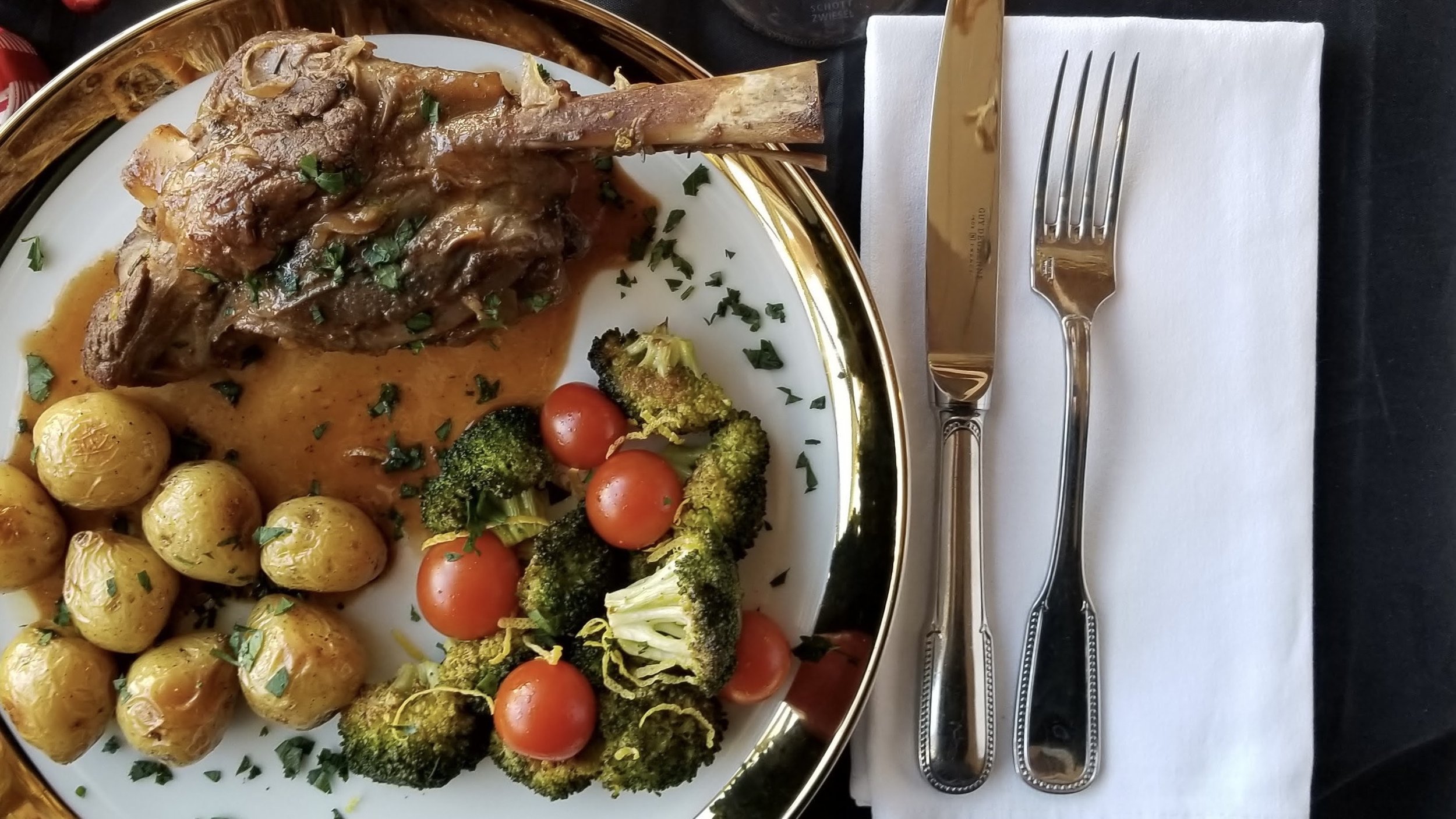LAMB SHANKS ALLA ROMANA
Instead of roasting an entire (entire hind end) leg of lamb, how about braising some of its forelegs, commonly known as shanks, in the “alla Romana” way.
The delish is in the fish. From the centuries B.C.E. until now, Romans often season their lamb dishes with fish.
Ancient Romans didn’t use salt in their cooking in the way that we do, or even as modern Roman cooks do. They used salt at the table, like us (in fact, the price of salt was kept artificially low by the government so that they could) but when they wanted to add salt in the kitchen, they used what we would call “fish sauce,” close to what Asian cooks use very freely in their cooking today.
They called their thick, salty-fishy sauce “garum” (or also “liquamen,” especially if the liquid was drawn off the mass of fermenting fish and salt). The most common fish used were the anchovy, smelt, mackerel or sprat; sometimes tuna made the recipe.
The use of garum in Roman cooking, indeed in the cooking all around the Mediterranean Sea, slowed after the Middle Ages, but it perdures to this day in uses of anchovy filets or anchovy paste in many a Mediterranean recipe.
The wee anchovy—and even a wee ratio of it in a whole recipe, as in today’s—introduces to cooked food gobs of umami, that very pleasant, savory, juicy, salivary taste set off by certain foods such as a sip of miso soup or a slice of sun-dried tomato.
I imagine that ancient Romans, far more than today’s cooks, were surfing waves of umami in their cooking and I am envious.
So, do not be shy to include the anchovy if you prepare these Roman-style lamb shanks. Trust me on this one; no fish taste, at all, blushes the dish. But umami does and, this Christmastime, that is a savor devoutly to be wished.
Two more cooking notes on this recipe: Do not use beef stock thinking that its robustness is necessary when preparing lamb. No, chicken stock is better, beef stock proving to be too much at the end of a long lamb braise. And even though lamb shanks are a devil to brown well, due to their odd shape, that browning is crucial to the finished dish. For the initial browning, even try to prop up on its widest end that face of each raw shank so that you can brown it, too.
A “foreleg” of Lamb Shank alla Romana.
Lamb Shanks alla Romana
Makes 4
Ingredients
4 lamb shanks, each in the neighborhood of 1-pound each
6 cloves garlic, peeled and sliced into slivers
2 tablespoons fruity olive oil
Kosher salt and freshly ground black pepper
2 medium onions, peeled and thinly sliced
1 mounded tablespoon dried rosemary needles, crushed well in the palm of the hand (or mix of dried rosemary and dried sage, crushed)
1 bay leaf
2 tablespoons tomato paste
3 anchovy filets or equivalent in anchovy paste
1 cup white wine or apple juice
3 tablespoons white wine vinegar
Up to 4 cups chicken broth, homemade or boxed
2 medium-to-large carrots, peeled and cut into small chunks (optional)
Directions
Take the 4 shanks and make many slits into their meat, inserting slivers of the garlic into the slits (as well as into the natural seams of the meat) until you’ve used it up. In a heavy-bottomed Dutch oven or pot over medium-high heat, brown the shanks well in the olive oil, turning them frequently so that as many sides as possible take on color. (Depending on the sizes of both the pot and the shanks you may need to do this in two batches, in order to avoid “steaming” them.)
Remove the shanks and set aside. In the fat that remains in the pot, cook the onions, seasoned with a dusting of salt and several grindings of pepper, for 7-8 minutes until they begin to brown, scraping up the browned bits of lamb from the bottom of the pot.
Add the herbs, tomato paste and anchovy, stirring them into the onions until they become fragrant, 30-45 seconds. Add the wine or juice and the vinegar, stirring, deglazing a final time and allowing some of the liquid to evaporate. Lay the lamb shanks as close as possible into 1 layer and pour enough chicken broth over and around them to come up to midway on the meat. Bring the pot to the boil.
Top the pot with the cover slightly ajar and cook slowly (just a simmer or very slow boil) for 1 and 1/2 to 2 hours, turning with tongs all 4 lamb shanks every 30 minutes. Add more broth, heated now, if the liquid gets close to evaporating away. Add the carrots, if you wish, 45 minutes before the end of cooking time, as best as you can estimate that. In the end, the meat need not be falling off the bone but be getting close to it.
It’s best if you can do all this a day or two ahead, separating away the shanks from the cooking liquid and refrigerating both at least overnight. The fat in the liquid will rise and congeal and is then easily removed. You may fashion a sauce from the liquid, straining out or keeping the solid matter as you wish, perhaps reducing the liquid a bit, or blending the solid material back into the liquid with an immersion or other blender.
Serve as the centerpiece to the plate garnished with chopped flat-leaf parsley.
